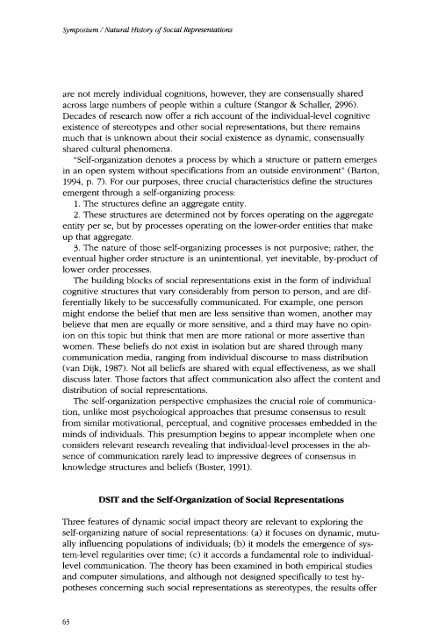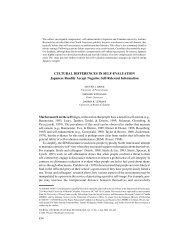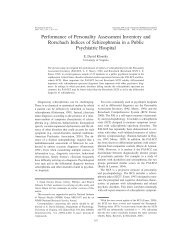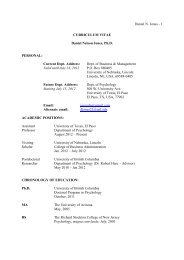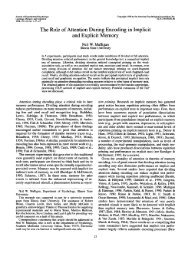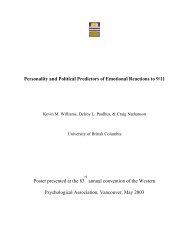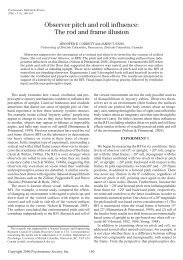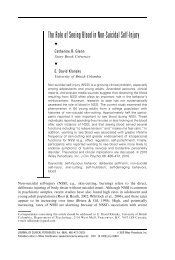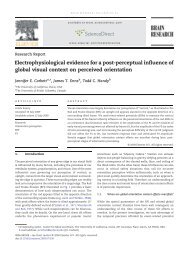Dynamic Social Impact and the Evolution of Social Representations ...
Dynamic Social Impact and the Evolution of Social Representations ...
Dynamic Social Impact and the Evolution of Social Representations ...
Create successful ePaper yourself
Turn your PDF publications into a flip-book with our unique Google optimized e-Paper software.
Symposium /Natural History <strong>of</strong> <strong>Social</strong> <strong>Representations</strong><br />
are not merely individual cognitions, however, <strong>the</strong>y are consensually shared<br />
across large numbers <strong>of</strong> people within a culture (Stangor & Schaller, 2996).<br />
Decades <strong>of</strong> research now <strong>of</strong>fer a rich account <strong>of</strong> <strong>the</strong> individual-level cognitive<br />
existence <strong>of</strong> stereotypes <strong>and</strong> o<strong>the</strong>r social representations, but <strong>the</strong>re remains<br />
much that is unknown about <strong>the</strong>ir social existence as dynamic, consensually<br />
shared cultural phenomena.<br />
“Self-organization denotes a process by which a structure or pattern emerges<br />
in an open system without specifications from an outside environment” (Barton,<br />
1994, p. 7). For our purposes, three crucial characteristics define <strong>the</strong> structures<br />
emergent through a self-organizing process:<br />
1. The structures define an aggregate entity.<br />
2. These structures are determined not by forces operating on <strong>the</strong> aggregate<br />
entity per se, but by processes operating on <strong>the</strong> lower-order entities that make<br />
up that aggregate.<br />
3. The nature <strong>of</strong> those self-organizing processes is not purposive; ra<strong>the</strong>r, <strong>the</strong><br />
eventual higher order structure is an unintentional, yet inevitable, by-product <strong>of</strong><br />
lower order processes.<br />
The building blocks <strong>of</strong> social representations exist in <strong>the</strong> form <strong>of</strong> individual<br />
cognitive structures that vary considerably from person to person, <strong>and</strong> are differentially<br />
likely to be successfully communicated. For example, one person<br />
might endorse <strong>the</strong> belief that men are less sensitive than women, ano<strong>the</strong>r may<br />
believe that men are equally or more sensitive, <strong>and</strong> a third may have no opinion<br />
on this topic but think that men are more rational or more assertive than<br />
women. These beliefs do not exist in isolation but are shared through many<br />
communication media, ranging from individual discourse to mass distribution<br />
(van Dijk, 1987). Not all beliefs are shared with equal effectiveness, as we shall<br />
discuss later. Those factors that affect communication also affect <strong>the</strong> content <strong>and</strong><br />
distribution <strong>of</strong> social representations.<br />
The self-organization perspective emphasizes <strong>the</strong> crucial role <strong>of</strong> communication,<br />
unlike most psychological approaches that presume consensus to result<br />
from similar motivational, perceptual, <strong>and</strong> cognitive processes embedded in <strong>the</strong><br />
minds <strong>of</strong> individuals. This presumption begins to appear incomplete when one<br />
considers relevant research revealing that individual-level processes in <strong>the</strong> absence<br />
<strong>of</strong> communication rarely lead to impressive degrees <strong>of</strong> consensus in<br />
knowledge structures <strong>and</strong> beliefs (Boster, 1991).<br />
DSIT <strong>and</strong> <strong>the</strong> Self-organization <strong>of</strong> <strong>Social</strong> <strong>Representations</strong><br />
Three features <strong>of</strong> dynamic social impact <strong>the</strong>ory are relevant to exploring <strong>the</strong><br />
self-organizing nature <strong>of</strong> social representations: (a) it focuses on dynamic, mutually<br />
influencing populations <strong>of</strong> individuals; (b) it models <strong>the</strong> emergence <strong>of</strong> system-level<br />
regularities over time; (c) it accords a fundamental role to individuallevel<br />
communication. The <strong>the</strong>ory has been examined in both empirical studies<br />
<strong>and</strong> computer simulations, <strong>and</strong> although not designed specifically to test hypo<strong>the</strong>ses<br />
concerning such social representations as stereotypes, <strong>the</strong> results <strong>of</strong>fer<br />
65


